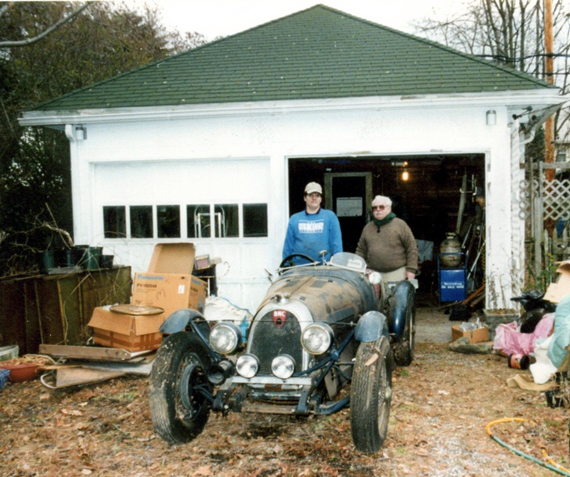
At left, Tony Lymber with John Gianella, who had so carefully and thankfully preserved the Caswell BNC. George Lymber photo.
A Franco-American Hybrid
By Eric Davison
No one knows how George Lymber’s BNC reached America. We do know that a legendary figure of the early days of sports car racing, Otto Linton, (who was of great help in writing these articles) was a close friend and business associate of George Caswell, who purchased the car from motorcycle dealer George Taylor sometime in the early 1940s. Since both Taylor and George Caswell have both passed along to the great racetrack in the sky, there are no details to be had about the arrival of the BNC to these shores.
It is known that Caswell was a pretty serious motorcycle racer in the 30s, and that he and Linton became friends and associates because of a shared interest in fast bikes and fast cars.
BNC cars were just about like everything else at the time. They were pretty straightforward. Small displacement – BNC cars utilized mostly 1000cc Ruby engines – they had elliptical springs front and rear. There were four BNC body styles, all very sporty but the car in question appears to be the Torpedo Sport, Paris-Biarritz, the sportiest of the bunch and very Bugatti-like in appearance.
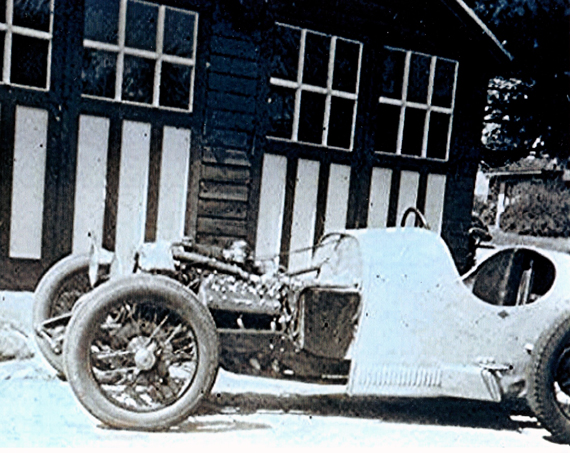
Otto Linton had this photo of the BNC taken in 1943 or 1944 as the Ford V8 60 was being installed. Nice fit but the original rear end was not up to it. Almost seventy years later, Sandy Leith recalled that the rear axle was supposed to have come out of a T30 Bugatti. Leith then had current owner Lymber verify the Bugatti S/N on the axle.
Caswell was interested in more performance than could be obtained by the little Ruby engine and he set about installing a Ford V8 60. Linton doesn’t remember ever seeing the little Ruby engine so it is possible that the car went to Caswell engineless. For those too young to know about the V8 60, it was Ford’s answer to the depressed economic times of the 1930s. The V8 60 was a cheaper alternative to the standard 85 hp V8 that powered most of Ford’s cars and trucks. 3
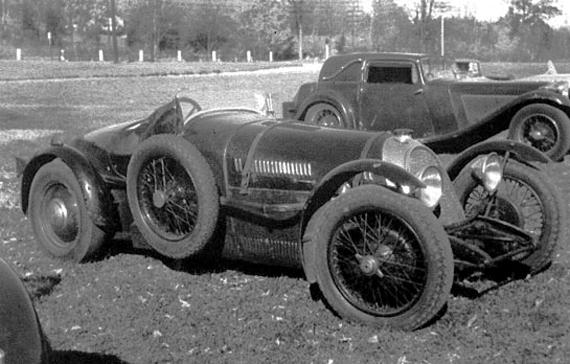
The BNC at an SCCA meet at Darien, Connecticut, probably in 1943. Now with the V8 engine, it appears roadworthy. Linton recalls that the cooling was marginal and it would overheat. This resulted in the change to the larger radiator and longer hood seen at the 1948 Watkins Glen Grand Prix. Otto Linton photo.
The V8 60 started life at 136 cubic inches and was produced in America through 1941. It was not a big success, most buyers preferring the bigger, faster standard 85 hp version. After the war the small V8 was replaced in the Ford line-up of engines by an in-line six. However, the tooling had been shipped to France where it powered a line of French Fords up to WW2 and after. Post war Ford Vedettes were V8 60-powered.
The V8 60 did find favor with a lot of performance seekers. V8 60s were a sweeping success on the midget racing circuits until the Offy made them and everything else obsolete. They were also stuffed under the hoods of a few sports cars. Phil Hill and Richie Ginther both drove a V8 60-powered MG TC, in California. John Fitch created the Fitch Type B, better known as the ‘Fitch Bitch’ by combining a V8 60 with a Fiat 1100 chassis and a highly modified Crosley Hotshot body. There were even a few small hydroplanes that utilized the V8 60.
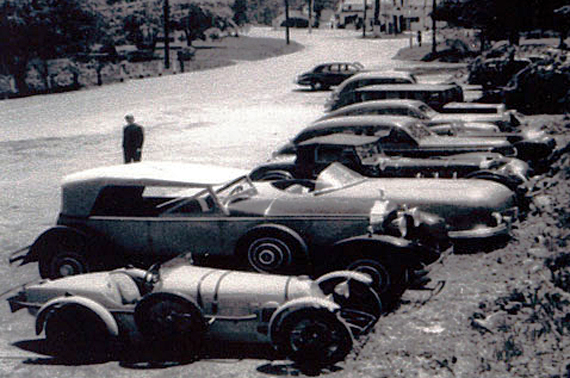
This is an evocative photo of an SCCA meet at Fairfield, Connecticut, probably in 1944. The BNC, now in primer, is seen with other SCCA cars of the era. The third car in line is the Russ Sceli Hudson 8 Complex, designed by Sceli with a Hudson 8 powerplant. Roger Barlow was the next owner and it disappeared in California. Photo courtesy Otto Linton.
Both Caswell and Linton wanted to join the SCCA and one of the requirements for full membership was ownership of a car identified by the SCCA as a true sports car. Otto Linton was in possession of a 1927 Duesenberg touring car. That was not a sports car. He located an Amilcar, acknowledged as a sports car, that was in need of an engine. 4
While Otto was not able to locate a suitable V8 60 for the Amilcar, Caswell did move ahead as fast as he could, finances permitting, to get his car up and running He had a brief setback when the motorcycle dealer temporarily retook possession of the car until the payment schedule was met.
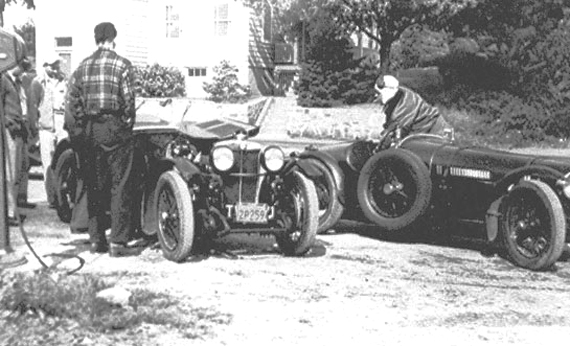
Otto Linton helped George Caswell with the BNC, but went on to buy an Amilcar and, sometime before 1948, a rare MG J4 which he raced at Watkins Glen that year. At left is Linton with the MG, standing behind the car. On the right, George Caswell in cloth helmet and the BNC.
Linton abandoned his Amilcar project and eventually purchased an MG J4, a nifty and rare supercharged model. In the picture of the start at Watkins Glen in 1948, Linton’s J4 is just behind Caswell’s BNC. 5
Caswell used the BNC in hillclimbs and other events along the east coast. He found that the standard radiator would not properly cool the newly modified car so a larger radiator was installed. Also, the light weight BNC rear axle was determined not to be up to the task and what George Lymber discovered to be a Bugatti rear axle was fitted. For a time the rear wheels and tires appeared to be of Ford origin with big hub caps and short, fat, spoked wheels. It is possible that the Ford axle setup was tried and proved to be either wrong in ratios or too heavy. Photos show that the possible Ford rear end might have been an intermediate or temporary step.
Caswell and Linton did find some competition events. Linton drove the car at Thompson Speedway in 1947 while Caswell participated in a hill climb in Fairfield, Connecticut in 1947, Langhorne Speedway in 1951 and the Giant’s Despair Hillclimb in 1951.
When the BNC appeared at Watkins Glen in 1948, the rear wheels appeared to be the originals but it is pretty certain that the Bugatti rear axle was in place. While the car appeared with a modified radiator, it seems that Caswell was later able to re-install the original and beautiful Bugatti-like radiator and shell.
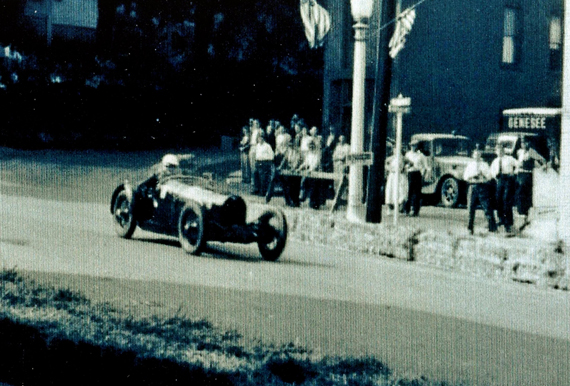
The Franco-American BNC's finest hour: Caswell at Milliken's Corner, Watkins Glen, 1948. Caswell would finish 8th overall. Evelyn Caswell photo.
The 1948 event was the first and last appearance at Watkins Glen for the BNC and for Caswell. Not so for Otto Linton, who later went on to race a couple of the most beautiful cars ever to appear there; a delightful Crosley powered Siata and later a two-liter Siata V-8 coupe.
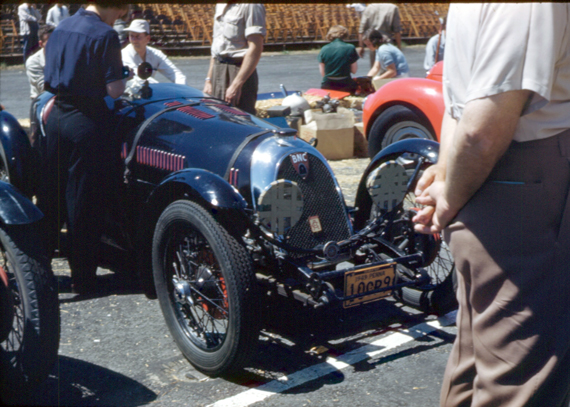
Bill Giltzow's father captured the Caswell BNC at Linden, N.J. in 1949. The original radiator was put back in place and overall, the car appears to be in excellent form. Bill also found the program to the 1949 Linden event, where Caswell had entered the BNC. Photo copyright Bill Giltzow.
Footnote 3
In a letter to George Lymber dated June 2009, Linton provides a detailed history of the BNC in the postwar period when in the hands of Caswell.
Footnote 4
“My 1927 Duesenberg touring did not qualify.” Letter from Linton to Vack dated 1-21-11. Caswell owned the BNC and Linton had to wait to find the Amilcar, which also needed an engine. However, that led to another find, the MGJ4 which he then used in SCCA events. By 1951, Linton was heavily involved in Italian cars such as the new Siatas.
Footnote 5
In a letter to Tony Carroll dated October 2010, Linton describes The Amilcar as a very special racing C6, (six cylinder DOHC) which after a long period of time was then sold to Chris Leydon at Leydon Restorations. It was, recalls Linton, really his third Amilcar.
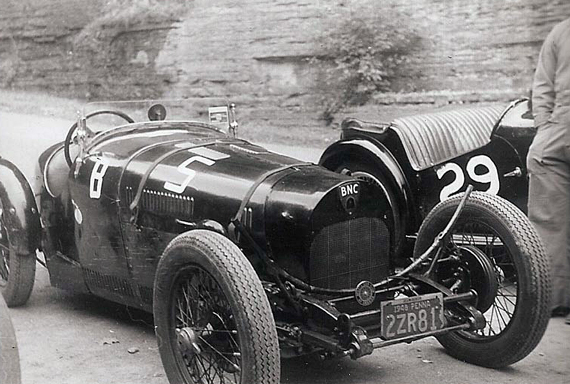
The SCCA was founded in 1944. Earlier sports car gatherings, such as the one in Darien in the picture, would probably have been put on by ARCA.
Great series of articles on the BNC.
Otto is a friend and I have had the enjoyment of meeting George last year at the Annual VSCCA luncheon.
My hope is that George will bring the BNC back to Watkins Glen for the Vintage Grand Prix Festival next September so it can be shared by all.
Back in the early 1960s, my dad and I built an autocross/street car with a Ford V8-60 motor attached to an Austin-Healey 4 speed with OD. It had a homemade fiberglass body which “looked like a Ferrari that had been in a bad wreck”, although many aspects of the front end resembled the early 240Z, which didn’t appear till 8 years later. NOTE that the V8-60 was originally designed for English Fords. My V8-60 was bored out to 2.5 liters but suffered a cylinder wall collapse after about 8000 miles.